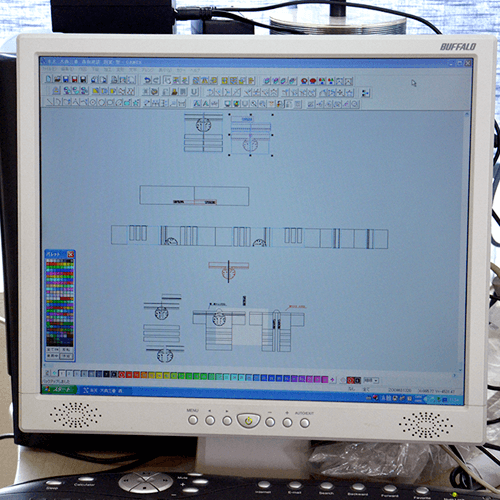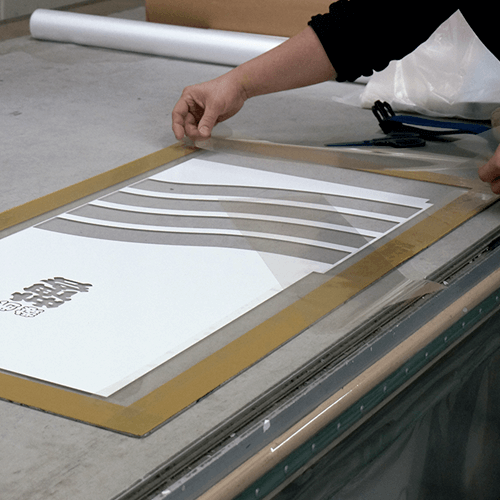SUGISHITA makes dyed products by selecting the best method of “Shirushizome,”
which uses
different Japanese traditional dyeing techniques, according to the
material, pattern, and purpose.
The following shows the processes of “Hikizome”
and “Nassen,” which are typical “Shirushizome”
(Honzome) methods.
“Hikizome”
Nassen
-
01
Patterning (Designing) and Preparing Paper Patterns
Our artisan hand-draws designs based on the characters, family crest,
or pattern, and prepares paper patterns with chisels. Recently, images
or illustrations can be imported to a PC and used for designing, and
even paper patterns can be created using a machine. This allows us to
try patterns that could not be designed in the past.


02
Making Colors
We mix dyes, do a test dyeing on a scrap of fabric, and dry it immediately
to check the color. This step is repeated while making small changes to
the mixing proportion each time until we obtain the target color. This is
because the color black, for example, is not simply one black color, but
comes in countless shades.
03
Applying a Paste
A sticky rice paste (resist paste) is applied to areas that need to remain white.
・Tsutsubiki (glue resist dyeing): Draw a sketch and apply a paste using a piping bag called “tsutsu.”
・Katanori-oki (paste application): Place the paper pattern on the fabric and apply the paste to the pattern using a spatula.
The process is finished by scattering sawdust or sand called “hikko” over the fabric and drying it for 6 a day.


04
Jiire (preparation)
This step prevents color unevenness and bleeding. A liquid containing a solution
of seaweed called “funori” is applied evenly to the fabric surface (dyed surface).
05
Dyeing and Steaming
Colors are dyed individually by our artisan using a different brush for each color.
The artisan moves their hand evenly to prevent uneven coloring. After dyeing,
the fabric is steamed to fix the colors (a dye fixing agent is sometimes used).


06
Washing and Drying
In this step, the fabric is washed. This washes away excess dyes inside the fabric
and the paste on the areas that need to remain white. For silk products,
the fabric is first hand-washed and then brushed with a scrubbing brush.
For cotton products, the fabric is machine-washed until excess dyes and paste are
removed while adjusting the water temperature. It is spin-dried and then dried
naturally in a room.
07
Finishing (Cutting and Sewing)
In this step, the product is finished as desired.
The fabric is ironed carefully to complete the process.
-
01
Patterning (Designing) and Preparing Paper Patterns
In “Nassen,” a paper pattern is prepared for each color. A product that is to be dyed
in five colors requires five paper patterns. Our artisan hand-draws designs based on the
characters, family crest, or pattern, and prepares paper patterns with chisels.
Recently, images or illustrations can be imported to a PC and used for designing,
and even paper patterns can be created using a machine. This allows us to try
patterns that could not be designed in the past.


02
Attaching Paper Patterns
The prepared paper pattern is attached to the silk screen. Paper
patterns (templates) are prepared, one for each color, according
to the number of colors to be used.
03
Making Color Pastes
A paste and dyes are mixed into a color paste. The mixing proportion
varies depending on the natural environment such as the climate, temperature,
and humidity of the day. Our artisan creates the target color paste by slightly
adjusting the dye mixing proportion based on their experience.


04
Squeegeeing and Dyeing
The silk screen with the paper pattern attached is placed on a white fabric, and
the color paste whose viscosity has been adjusted is spread over the screen evenly
using a spatula called a squeegee. This step is repeated as many times as the number
of colors to be used.
05
Drying and Steaming
The fabric is pulled using wooden frames and dried naturally in a room.
Then, it is steamed to fix the colors.


06
Washing and Drying
In this step, excess dyes are washed away.
The water temperature and washing time are adjusted while
checking the remaining dye. The fabric is spin-dried and then air-dried.
07
inishing (Cutting and Sewing)
In this step, the product is finished as desired.
The fabric is ironed carefully to complete the process.


